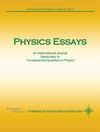由基本波线组成的光子模型。通过两个杨氏狭缝一个接一个地发射光子来获得干涉的现实解释
IF 0.5
Q4 PHYSICS, MULTIDISCIPLINARY
引用次数: 0
摘要
动态参考介质(DMR)理论已经在几篇文章中提出,特别是奥利维尔·皮纳德[物理学家]。论文32,422(2019)。本文的目的是在DMR理论的框架内提出一个光子模型。在亚原子水平上引入了基本波的概念。基本波在不断被新的引力子(构成波传播媒介的实体)更新时,总是与自身相同。这种基本波在其介质(DMR)中以光速传播,无论其轨迹如何。在附录b中提出了一种可能的基本波模型,称为光涡旋,然后引入了涡旋线的概念。构成一条线的涡的轴线彼此平行,垂直于传播方向,中间间隔半个波长,在一个方向和另一个方向交替旋转。所提出的光子的模型是一组彼此平行的漩涡线(无论光子的频率如何,漩涡线的数量以及光子的长度都是常数)。这个模型使得我们可以将速度c、频率ν、周期T = 1/ ν、波长λ = c / ν、能量E = hν、动量p = E / c = h·ν / c,甚至偏振(直线、圆形或椭圆)归为光子。首先,它允许解释光子同时具有波的方面(因为只由基本波组成)和微粒的方面(因为基本波与自身保持相同,光子仍然被相同的体积所限定)。它还解释了通过狭缝一个接一个地发射光子的衍射现象,以及通过两个杨氏狭缝一个接一个地发射光子的干涉现象。本文章由计算机程序翻译,如有差异,请以英文原文为准。
Model of the photon made up of lines of elementary waves. Realistic explanation of obtaining interferences by emitting photons one by one through two Young’s slits
The theory of the dynamic medium of reference (DMR) has already been presented in several articles, in particular, by Olivier Pignard [Phys. Essays 32 , 422 (2019)]. The objective of this article is to present a model of the photon within the framework of the DMR theory. A concept of elementary wave on the subatomic level is introduced. An elementary wave is always identical to itself while being constantly renewed by new gravitons (entities that make up the medium of propagation of the wave). This elementary wave propagates in its medium (DMR) at the speed of light whatever its trajectory. A possible model of the elementary wave called light-vortex is presented in Appendix B. Then the concept of line of vortices is introduced. The vortices constituting a line all have their axis parallel to each other and perpendicular to the direction of propagation are separated by half a wavelength and rotate alternately in one direction and the other. The model of the proposed photon is then a set of lines of vortices parallel to each other (the number of lines of vortices as well as the length of the photon are constants whatever the frequency of the photon.) This model makes it possible to attribute to the photon, the speed c , a frequency ν , a period T = 1/ ν , a wavelength λ = c / ν , the energy E = hν , the momentum p = E / c = h · ν / c , and even a polarization (rectilinear, circular, or elliptical). It allows above all to explain that the photon has at the same time a wave aspect (because composed only of elementary waves) and a corpuscular aspect (since the elementary waves remain identical to themselves and the photon remains delimited by the same volume). It also explains the phenomenon of diffraction by emitting photons, even one by one, through a slit and that of interferences by emitting photons, even one by one, through two Young’s slits.
求助全文
通过发布文献求助,成功后即可免费获取论文全文。
去求助
来源期刊

Physics Essays
PHYSICS, MULTIDISCIPLINARY-
自引率
83.30%
发文量
50
审稿时长
6-12 weeks
期刊介绍:
Physics Essays has been established as an international journal dedicated to theoretical and experimental aspects of fundamental problems in Physics and, generally, to the advancement of basic knowledge of Physics. The Journal’s mandate is to publish rigorous and methodological examinations of past, current, and advanced concepts, methods and results in physics research. Physics Essays dedicates itself to the publication of stimulating exploratory, and original papers in a variety of physics disciplines, such as spectroscopy, quantum mechanics, particle physics, electromagnetic theory, astrophysics, space physics, mathematical methods in physics, plasma physics, philosophical aspects of physics, chemical physics, and relativity.
 求助内容:
求助内容: 应助结果提醒方式:
应助结果提醒方式:


